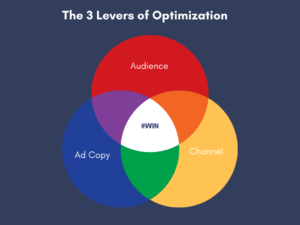So you’ve managed to launch an effective UA campaign that generates an impressive ROAS on your $20K budget. You may even be generating $40-60K from that modest ad budget. That’s the way it goes when you plan your strategy, refine your messaging and segment your audiences. Good on you!
The only problem is that everytime you try to scale your budget, your ROAS shrinks and your profitability goes down. It seems that your well-crafted campaigns only perform well on small budgets. Don’t fret, you’re not alone. Most eCommerce brand owners that I work with complain about the exact same problem. And it’s not your fault, your campaigns are great.
The issue is that the same creatives and offers that work on small scale audiences won’t necessarily work as well when you try to expand your reach. You’re suddenly exposing your creatives to entirely new audiences with different needs, pains and motivations. Bottom line is that they engage with your campaigns less frequently than your original audience, which drives up their CPCs. They may be less relevant or spend less time on Facebook, but no matter the reason for their higher CPCs, you should always consider large-scale audiences an entirely different beast.
In my last three articles we covered everything you need to do to launch your scale up campaigns, from setting up a scale up strategy, to crafting tight ad copy and all the way to segmenting your audiences. But, now that your campaigns are running it’s time to discuss what is perhaps the most critical aspect of running high performance user acquisition campaigns– campaign optimization.
 Continuous Campaign Optimization Increases CTRs
Continuous Campaign Optimization Increases CTRs
Even the best laid UA plans require constant refinement; perhaps optimization would be even a better way to put it. Maintaining profitability at scale demands that you constantly devise new approaches for your campaigns. There is no auto-pilot when it comes to optimizing large scale campaigns.
Effective campaign optimization requires constant, ongoing effort to ensure that you’re delivering the optimal creative and messaging for each audience, on each channel that you’re targeting. Qualitative and quantitative data needs to be scoured for the insights that will drive your optimization decisions. Close attention needs to be paid to every metric of your campaign, as you’ll never know which insights will drive your next optimization decision.
Neverending experimentation is essential. If you see that campaigns are under-delivering, try out new channels like TikTok that offer lower CPMs. Dedicate a small part of your budget to experimentation. See how different audiences react to different messages and creatives on small budget campaigns to find the perfect mix before you scale up your spend.
Allocating Dedicated Personnel for Your Optimization Efforts
But before I get into exactly how you do this, it’s important that you understand that effective optimization requires dedicated effort. If you think you can handle large-scale optimization as an afterthought then please think again. You’ll need a dedicated professional to handle this on an ongoing basis. This professional will need to know the ins and outs of each one of your campaigns while taking your overall strategy into account.
They can either be someone from your inhouse team or an outsourced freelancer or agency. The only thing that matters is that you’ve got someone constantly monitoring your campaign metrics to ensure that you’re boosting and refining only those campaigns that are delivering the best results.
In my work, optimization is an ongoing effort that is done in full cooperation with my clients. After we’ve set up our initial strategy (KPIs, Avatars, Channel allocation) for our campaigns we hold weekly strategy optimization meetings where we pour over the data. We look at how much is going out and how much is going in, while constantly thinking up new ways to replicate and leverage the success of our more profitable campaigns.
The 3 Levers of Optimization
Optimization isn’t as complicated as you may think. It boils down to 3 pretty basic possibilities; you can optimize your: audience, creatives and channels, that’s it. They’re all pretty much intertwined, but I suggest you start optimizing your audience targeting. Once you’ve refined your targeting to smaller, more relevant audiences, start optimizing ad copy and thinking about which channels are best suited to that specific demographic.
You also really only have one tool for optimization, your budget allocation decisions. By moving the budget from one campaign to another you’re optimizing that one campaign while deprioritizing, or entirely killing, another.
Audience Optimization. Believe it or not, there are endless levels of granularity within an audience. Looking at your campaign results will reveal a wealth of actionable insights. You may see that women aged 35-45 convert better than 18-25, meaning that budget should be allocated away from the younger demographic towards the older one. See if you can find seasonal or calendar-driven patterns in your data that help you understand why a particular audience converts better than others. For example, you may see that towards the holidays, or the summer nuptial season, men aged 30-50 purchase more of your jewelry products. There’s a good chance that this is because they’re purchasing holiday or anniversary gifts for their better halves.
Ad Copy Optimization. The more personalized your copy is, the better the chance that it will convert. Speak directly to your customers about their pains, and motivations–now that you’ve narrowed down your audiences, it’ll be easier to get rid of generic, product value-driven messages and focus more on highly relevant ad copy that highlights your product’s value for that specific audience. Here again your Customer Avatar should serve as your inspiration, but you’ve got to make sure that your Avatar represents your newly optimized audiences. If it doesn’t, go back to the drawing board and create a new one that does. You can also lean on insightful qualitative data for your messaging by looking at customer reviews and customer service tickets.
Channel Optimization. Some channels convert better with certain audiences than others, that’s the way the online ad world works. Here again you’ve got to rely on your campaign results to guide your optimization decisions. You may see that your optimized audience converts better from Facebook Ads than Google Shopping Ads. Guess what? You’ve got to move the budget away from Google and funnel it into Facebook. You may see that of your 5 Facebook campaigns, only one is delivering your benchmark 300% ROAS. That’s where you’ve got to put your budget, focus on it.
Try out different formats within a given channel to see which works best. If video works, double down on that format. If Carousel ads aren’t performing, shift that budget away from Carousels and make 5 different videos for your campaigns.
Conclusion
Online advertising is a never ending game of trial and error. To succeed at scale requires constant monitoring and optimization to find the perfect mix of audience, channel, creative and even ad format. There’s no resting on your laurels when it comes to optimization. You’ve got to devote constant attention to campaign results so that you can quickly replicate your successes for high performing campaigns and minimize your losses on those that don’t perform well.


